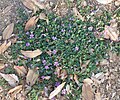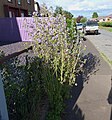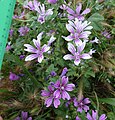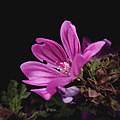Malva sylvestris

| Malva sylvestris | |
|---|---|
 | |
| Type species for Malva L. | |
| Scientific classification | |
| Kingdom: | Plantae |
| Clade: | Tracheophytes |
| Clade: | Angiosperms |
| Clade: | Eudicots |
| Clade: | Rosids |
| Order: | Malvales |
| Family: | Malvaceae |
| Genus: | Malva |
| Species: | M. sylvestris |
| Binomial name | |
| Malva sylvestris | |
| Synonyms [1][2] | |
| |
Malva sylvestris is a species of the mallow genus Malva in the family of Malvaceae and is considered to be the type species for the genus. Known as common mallow to English-speaking Europeans,[3] it acquired the common names of cheeses, high mallow and tall mallow (mauve des bois by the French)[4] as it migrated from its native home in Western Europe, North Africa and Asia through the English-speaking world.[5]
M. sylvestris is a vigorous plant with showy flowers of bright mauve-purple, with dark veins, standing 3–4 feet (0.91–1.22 m) high and growing freely in meadows, hedgerows and in fallow fields.[6]
Common names
[edit]It is one of several species of different genera sometimes referred to as Creeping Charlie, a term more commonly applied to Glechoma hederacea (ground ivy).[7]
Description
[edit]Common mallow is a herbaceous perennial with an erect or decumbent branched stem up to 1 m (sometimes 1.5 m) long. The minutely-ridged stems are covered with fine soft hairs, sometimes with a slightly bulbous base. The leaves are alternate, with a petiole up to 20 cm long, simple but palmate, up to 7 cm long by 10 cm wide, with stellate hairs (i.e. several strands radiating from a common center) and prominent veins on the underside.[8][9]

The flowers are reddish-purple with dark stripes and occur in axillary clusters of 2 to 4 along the main stem with the flowers at the base opening first. There are 5 petals, each being up to 20 mm long, and 5 sepals, 3-6 mm long, which are fused in the lower half, and have broadly triangular lobes. There is also an epicalyx (or false calyx) with oblong segments, two-thirds as long as calyx lobes (2–3 mm long x 1.5 mm wide).[5][10]
Fruits
[edit]Nutlets strongly reticulate (10–12 mericarps, usually without hair, with sharp angle between dorsal and lateral surfaces, 5–6 mm in diameter.[3][5]
Seeds
[edit]Also called 'cheeses,'[6] seeds are brown to brownish green when ripe, about 2.5 millimeters long and wide[5][11] 5 to 7 millimeters in diameter[11] and are shaped like a cheese wheel.
Distribution and habitat
[edit]Malva sylvestris spreads itself on waste and rough ground, by roads and railways throughout lowland England, Wales and Channel Islands, Siberia and scattered elsewhere.[3][9] One of the major areas that Malva sylvestris grows is northeast and central Iran. It is also found in North Africa,[12] grows as a biennial[5][9] in the Mediterranean[12] and grows as a perennial elsewhere.[12][11] It has been introduced to and has become naturalised in eastern Australia,[11] in the United States, Canada, and Mexico as an invasive species.[9]
In the wild
[edit]- Palearctic:
- Macaronesia: Azores, Madeira Islands
- Northern Africa: Algeria, Egypt, Libya, Morocco
- Arabian Peninsula: Saudi Arabia
- Western Asia: Afghanistan, Sinai, Iran, Palestine, Jordan, Lebanon, Syria, Turkey
- Caucasus: Armenia, Azerbaijan, Ciscaucasia, Dagestan, Georgia
- Soviet Middle Asia: Kyrgyzstan, Tajikistan, Turkmenistan, Uzbekistan
- Mongolia: Mongolia
- China: Xinjiang
- Indian Subcontinent: Bhutan, India, Pakistan
- Northern Europe: Denmark, Finland, Ireland, Norway, Sweden, United Kingdom
- Middle Europe: Austria, Belgium, Czech Republic, Germany, Hungary, Netherlands, Poland, Slovakia, Switzerland
- East Europe: Belarus, Central Russia, Central Black Earth, Estonia, Latvia, Lithuania, Moldova, Northern Russia, North Caucasus, Northwestern Russia, Volga, Urals, Volga-Vyatka, Ukraine
- Southeastern Europe: Albania, Bosnia and Herzegovina, Bulgaria, Croatia, Greece, Italy, Macedonia, Montenegro, Sardinia, Serbia, Sicily, Slovenia, Romania, Cyprus
- Southwestern Europe: Balearic Islands, Corsica, France, Portugal, Spain
Source: USDA ARS GRIN[4]
Uses
[edit]This section needs additional citations for verification. (August 2021) |

Mauve, n. F., mallow, L. malva. So named from the similarity of the color to that of the petals of common mallow, {Malva sylvestris}.
In 1931, Maud Grieve wrote that the "use of this species of Mallow has been much superseded by marsh-mallow (Althaea officinalis), which possesses its properties in a superior degree, but it is still a favorite remedy with country people where marsh-mallow is not obtainable."[6] The flowers were spread on doorways and woven into garlands or chaplets for celebrating May Day.[6] The boiled young leaves are a vegetable eaten in several parts of Europe in the 19th century.[13]
M. sylvestris has traditionally been used around the world as a wild food plant, from the Mediterranean[14] and Middle East, including Palestine[15] and Italy,[16] to the Caucasus.[17]
In Morocco, Tunisia and Palestine, Malva leaves are steamed with garlic and tomatoes, and eaten as an appetizer or salad. In Egypt, the leaves are made into a stew-like vegetable dish, especially in winter, known as khobeiza, which is similar to Molokheia.[18]
In traditional medicine, M. sylvestris has been used in herbalism. Mucilage is present in many of the family Malvaceae including M. sylvestris,[19][20] especially the fruit.[21] The seeds are used internally in a decoction or herbal tea as a demulcent,[13] and the leaves may be used in poultices as an emollient for external applications.[21]
The species has long been used as a natural yellow dye,[22] and dyes of various yellow-green colors can be obtained from the plant and its seeds.[23] A tincture of the flowers can make a sensitive test for alkalis.[6]
M. sylvestris has also been used for veterinary purposes.[24]
Subspecies
[edit]Plants previously often described as Malva sylvestris var. malaca are now considered a cultivar group Malva sylvestris Mauritiana group.[12]
Cultivation
[edit]
It is often grown as an ornamental plant for its attractive flowers, produced for a long period through the summer. Numerous cultivars have been selected and named.
Cultivars of Malva sylvestris include: 'Annita', 'Aurora', 'Bardsey Blue', 'Blue Fountain', 'Brave Heart', 'Cottenham Blue', 'Gibbortello', 'Harry Hay', 'Highnam', 'Inky Stripe', 'Knockout', 'Magic Hollyhock', 'Mest', 'Mystic Merlin', 'Perry's Blue', 'Purple Satin', 'Richard Perry', 'Tournai', 'Windsor Castle', 'Zebrina' (soft lavender-purple striped with deep maroon veins) [25] and 'Zebrina Zebra Magis'.
Cultivar groups
[edit]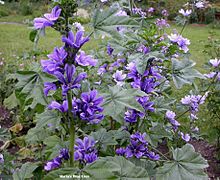
- Malva sylvestris L. Mauritiana group: Swedish: mauretansk rödmalva, Estonian: mauri kassinaeris, Slovene: Mavretanski slezenovec, Hungarian: mórmályva. Malva mauritiana used to be recognized as a species whose range is Iberia, Italy and Algeria. Garden plants are often called Malva sylvestris var. mauritiana and they make a cultivar group that includes:
- 'Bibor Felho'
- 'Moravia'
- Malva sylvestris L. Eriocarpa group: Hairy seeds and hairy stems found between Italy and the Himalayas, Central Asia and China.
- Malva sylvestris L. Canescens group: Every part except for the flower is covered with dense white woolly hair, growing in the Montpellier region of France, and on the Balearic Isles. Some 19th-century botanical works called this group Malva sylvestris L. var. canescens.
- Malva sylvestris L. Sterile Blue group: Vegetatively propagated pale violet-blue flowered cultivars:
- Marina 'Dema'
- 'Primley Blue'
- 'Maria's Blue Eyes' (dark violet-blue flowered)
Virus
[edit]Malva vein clearing potyvirus which is transmitted by mechanical inoculation in a non-persistent manner via insects, such as Aphis umbrella (syn. Aphis malvae Koch) and Myzus persicae (all are Aphididae). The virus can be found in Tasmania, Brazil, the former Czechoslovakia, Germany, Israel, Italy, Portugal, California, Russia and the former Yugoslavia.[26][27]
Chemistry
[edit]M. sylvestris contains malvin and malonylmalvin.[28] It also contains the naphthoquinone malvone A, which is also a phytoalexin.[29]
Botanical gallery
[edit]- Standard upright, spreading form; flowers large but quite variable
- Standard upright form; flowers large
- Trampled or mown form, stays close to ground
- Tall form (cultivated escapee)
- Inflorescence top
- Flowers generally large, bold coloured
- May be lighter coloured
- Colour may be rather bold
- Floral organs
- Calyx 5-part, parts broad (narrow epicalyx also showing)
- Epicalyx 3-part, parts narrow to moderately broad
- Epicalyx 3-part, parts narrow to moderately broad
- Inflorescence showing features above
- Inflorescence top showing features above
- Fruit immature, wrinkles starting to show, hairy form (var. eriocarpa)
- Fruit wrinkled, hairless form
- Fruit, hairless form
- Hairs bulbous-based (may be less apparent)
- Hairs of cultivated plant, very weak with bulbous bases not very conspicuous
- Leaf upperside
- Leaf underside
References
[edit]- ^ "Flora Europaea Search Results". Flora Europaea. Royal Botanic Garden Edinburgh. Retrieved 9 May 2008.
- ^ "Malva sylvestris L. record n° 81830". African Plants Database. South African National Biodiversity Institute, the Conservatoire et Jardin botaniques de la Ville de Genève and Tela Botanica. Archived from the original on 1 January 2013. Retrieved 9 May 2008.
- ^ a b c C. Stace. R. van der Meijden, I. de Kort (eds.). "Malva sylvestris (Mallow, Common)". Interactive Flora of NW Europe. Netherlands Biodiversity Information Facility. Retrieved 9 May 2008.[permanent dead link]
- ^ a b Germplasm Resources Information Network (GRIN) (20 May 1992). "Taxon: Malva sylvestris L." Taxonomy for Plants. USDA, ARS, National Genetic Resources Program, National Germplasm Resources Laboratory, Beltsville, Maryland. Retrieved 9 May 2008. [dead link]
- ^ a b c d e Flora of Pakistan. "Malva sylvestris Linn". Retrieved 9 May 2008.
- ^ a b c d e M. Grieve (1931). "MALLOW, BLUE". A Modern Herbal. Botanical.com.
- ^ Sinclair P (7 October 1999). "creeping charlie". Plantbio mailing list (Mailing list). Retrieved 10 May 2008.
- ^ Poland J, Clement E (2009). The Vegetative Key to the British Flora. Southampton: John Poland. ISBN 978-0-9560144-0-5.
- ^ a b c d Britton N, Addison Brown (1913). "CYRILLACEAE". An illustrated flora of the northern United States, Canada and the British possessions. Volume II, Amaranthaceae to Loganiaceae. Charles Scribner's Sons. pp. 2052 pages. Retrieved 10 May 2008.
- ^ Stace C (2019). New Flora of the British Isles. Suffolk: C & M Floristics. ISBN 978-1-5272-2630-2.
- ^ a b c d National Herbarium of New South Wales. "Search PlantNET". New South Wales FloraOnline. Royal Botanic Gardens, Sydney. Retrieved 9 May 2008.
- ^ a b c d Stewart Robert Hinsley. "Malva sylvestris (section Malva, in part)". The Malva Pages. Archived from the original on 3 July 2013. Retrieved 9 May 2008.
- ^ a b Hiley JS (1841). "On the medical botany of the province of Halifax". In Thomas Wakley (ed.). The Lancet, In Two Volumes (Volume The Second ed.). J. Onwhyn. Retrieved 10 May 2008.
- ^ Barros L, Carvalho AM, Ferreira IC (June 2010). "Leaves, flowers, immature fruits and leafy flowered stems of Malva sylvestris: A comparative study of the nutraceutical potential and composition". Food and Chemical Toxicology. 48 (6): 1466–1472. doi:10.1016/j.fct.2010.03.012. PMID 20233600.
- ^ Ali-Shtayeh MS, Jamous RM, Al-Shafie' JH, et al. (12 May 2008). "Traditional knowledge of wild edible plants used in Palestine (Northern West Bank): A comparative study". Journal of Ethnobiology and Ethnomedicine. 4 (1): 13. doi:10.1186/1746-4269-4-13. PMC 2396604. PMID 18474107.
- ^ Guarrera P, Savo V (June 2016). "Wild food plants used in traditional vegetable mixtures in Italy". Journal of Ethnopharmacology. 185: 202–234. doi:10.1016/j.jep.2016.02.050. PMID 26944238.
- ^ Batsatsashvili K, Mehdiyeva NP, Fayvush G, et al. (2017). "Malva neglecta Wallr. Malva sylvestris L. Malvaceae". Ethnobotany of the Caucasus. European Ethnobotany. pp. 395–403. doi:10.1007/978-3-319-49412-8_115. ISBN 978-3-319-49411-1.
- ^ "CVAR | Did You Know? Molokhia/Moloha". CVAR | Did You Know? Molokhia/Moloha. Retrieved 7 March 2024.
- ^ Balfour JH (1863). "Products and Secretions of Plants". A manual of botany: being an introduction to the study of the structure, physiology, and classification of plants. Edinburgh: A & C Black. Retrieved 10 May 2008.
- ^ Balfour JH (1863). "Malvaceae". A manual of botany: being an introduction to the study of the structure, physiology, and classification of plants. Edinburgh: A & C Black. Retrieved 10 May 2008.
- ^ a b Dey KL, Mair W (1896). "Indigenous Drugs of India". The indigenous drugs of India: short descriptive notices of the principal medicinal products met with in British India. Thacker, Spink & Co. pp. 387 pages. Retrieved 10 May 2008.
- ^ Bailey LH (1910). "Dyes and Dyeing. C.S. Doggert". Cyclopedia of American agriculture: a popular survey of agricultural conditions, practices and ideals in the United States and Canada, In Four Volumes. Volume II --Crops. Macmillan Publishers. pp. 2016 pages. Retrieved 10 May 2008.
- ^ "Malva sylvestris L." Plants for a Future. Retrieved 10 May 2008.
- ^ Gasparetto JC, Martins CA, Hayashi SS, et al. (4 January 2012). "Ethnobotanical and scientific aspects of Malva sylvestris L.: a millennial herbal medicine". Journal of Pharmacy and Pharmacology. 64 (2): 172–189. doi:10.1111/j.2042-7158.2011.01383.x. PMID 22221093. S2CID 40277008.
- ^ Heritage Perennials: Malva sylvestris 'Zebrina'
- ^ "00.057.0.81.049. Malva vein clearing virus". ICTVdB Management. Columbia University. 2006. Retrieved 10 May 2008.
- ^ Brunt, A.A., Crabtree, K., Dallwitz, M.J., Gibbs, A.J., Watson, L., Zurcher, E.J., eds. (August 1996). "Descriptions and Lists from the VIDE Database: Malva vein clearing potyvirus". Plant Viruses Online. University of Idaho. Archived from the original on 11 May 2008. Retrieved 10 May 2008.
- ^ Takeda K, Enoki S, Harborne JB, et al. (January 1989). "Malonated anthocyanins in malvaceae: Malonylmalvin from Malva sylvestris". Phytochemistry. 28 (2): 499–500. Bibcode:1989PChem..28..499T. doi:10.1016/0031-9422(89)80040-8.
- ^ Veshkurova O, Golubenko Z, Pshenichnov E, et al. (November 2006). "Malvone A, a phytoalexin found in Malva sylvestris (family Malvaceae)". Phytochemistry. 67 (21): 2376–2379. Bibcode:2006PChem..67.2376V. doi:10.1016/j.phytochem.2006.08.010. PMID 16996095.
External links
[edit] Media related to Malva sylvestris at Wikimedia Commons
Media related to Malva sylvestris at Wikimedia Commons Data related to Malva sylvestris at Wikispecies
Data related to Malva sylvestris at Wikispecies- "Malva sylvestris". Plants for a Future.
- "Malva sylvestris". Calflora. Berkeley, California: The Calflora Database.
- Malva sylvestris in the CalPhotos photo database, University of California, Berkeley
- UniProt. "Malva sylvestris". Retrieved 10 May 2008.


